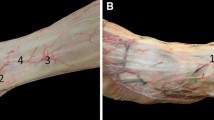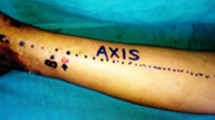Abstract
Introduction
Soft tissue defects of foot and ankle are challenging due to the susceptibility of the area to trauma and the complexity of the region. Several flaps have been described for wound coverage after surgical debridement at this location. The purpose of this study is to present the reverse sural flap for covering soft tissue defects at the ankle and foot.
Materials and methods
From July 2014 to November 2017, ten patients with soft tissue defect at the ankle and foot were retrospectively reviewed. There were nine men and one woman with a mean age of 40.5 years (range 17-71 years). Seven patients were smokers and five were diabetics. The mean size of the defect was 50.5 cm2. All operations were performed by the same microsurgical team. At a mean follow-up of 21 months (range, 18 to 24 months), we evaluated wound healing and complications.
Results
In nine patients, the soft tissue defect was successfully covered. In four patients, venous congestion was noticed, whereas in one patient, there was total necrosis of the flap. In all cases, the donor site was healed uneventfully.
Conclusion
The reverse sural artery flap is a reliable alternative for wound coverage at the ankle and foot, with low complication and morbidity rate. Nevertheless, it is a demanding microsurgical operation that requires knowledge of the anatomy and surgeons' experience.



Similar content being viewed by others
References
Moran SL, Cooney WP (2009) Soft tissue surgery. Lippincott Williams & Wilkins, Philadelphia
Touam C, Rostoucher P, Bhatia A, Oberlin C (2001) Comparative study of two series of distally based fasciocutaneous flaps for coverage of the lower one-fourth of the leg, the ankle, and the foot. Plast Reconstr Surg 107(2):383–392. https://doi.org/10.1097/00006534-200102000-00013
Köse R, Mordeniz C, Şanli Ç (2011) Use of expanded reverse sural artery flap in lower extremity reconstruction. J Foot Ankle Surg 50(6):695–698. https://doi.org/10.1053/j.jfas.2011.06.007
Chai Y, Zeng B, Zhang F, Kang Q, Yang Q (2007) Experience with the distally based sural neurofasciocutaneous flap supplied by the terminal perforator of peroneal vessels for ankle and foot reconstruction. Ann Plast Surg 59(5):526–531. https://doi.org/10.1097/01.sap.0000258969.13723.68
Gu H, Xiong Z, Xu J, Li G, Wang C (2013) Clinical and anatomical study of the distally based lesser saphenous veno-lateral sural neurocutaneous flap for lower extremity coverage. J Orthop Sci Off J Jpn Orthop Assoc 18(5):740–748. https://doi.org/10.1007/s00776-013-0434-x
Masquelet A, Romana M, Wolf G (1992) Skin island flaps supplied by the vascular axis of the sensitive superficial nerves: anatomic study and clinical experience in the leg. Plast Reconstr Surg 89(6):1115–1121
Hasegawa M, Torii S, Katoh H, Esaki S (1994) The distally based superficial sural artery flap. Plast Reconstr Surg 93(5):1012–1020
Cavadas PC, Bonanad E (1996) Reverse-flow sural island flap in the varicose leg. Plast Reconstr Surg 98(5):901–902
Chang SM, Zhang K, Li HF, Huang YG, Zhou JQ, Yuan F, Yu GR (2009) Distally based sural fasciomyocutaneous flap: anatomic study and modified technique for complicated wounds of the lower third leg and weight bearing heel. Microsurg Off J Int Microsurg Soc Eur Fed Soc Microsurg 29(3):205–213. https://doi.org/10.1002/micr.20595
Kansal S, Goil P, Singh J (2011) Surgical review: the versatile reverse flow sural artery flap for lower 1/3 leg and foot defects: clinical series. Eur J Orthop Surg Traumatol 21(8):553–556. https://doi.org/10.1007/s00590-011-0768-z
Gustilo RB, Anderson JT (1976) Prevention of infection in the treatment of one thousand and twenty-five open fractures of long bones: retrospective and prospective analyses. J Bone Jt Surg Am 58(4):453–458
Yilmaz M, Karatas O, Barutcu A (1998) The distally based superficial sural artery island flap: clinical experiences and modifications. Plast Reconstr Surg 102(7):2358–2367. https://doi.org/10.1097/00006534-199812000-00013
Kang MJ, Chung CH, Chang YJ, Kim KH (2013) Reconstruction of the lower extremity using free flaps. Arch Plast Surg 40(5):575. https://doi.org/10.5999/aps.2013.40.5.575
Yildirim S, Akan M, Aköz T (2002) Soft-tissue reconstruction of the foot with distally based neurocutaneous flaps in diabetic patients. Ann Plast Surg 48(3):258–264
Yoshimura M, Imura S, Shimamura K, Yamauchi S, Nomura S (1984) Peroneal flap for reconstruction in the extremity: preliminary report. Plast Reconstr Surg 74(3):402–409
Hong G, Steffens K, Wang FB (1989) Reconstruction of the lower leg and foot with the reverse pedicled posterior tibial fasciocutaneous flap. Br J Plast Surg 42(5):512–516. https://doi.org/10.1016/0007-1226(89)90035-0
Osman GMA (2004) Reverse-flow sural flap: clinical experiences and idea and innovation. AAMJ 2(2)
Baumeister SP, Spierer R, Erdmann D, Sweis R, Levin LS, Germann GK (2003) A realistic complication analysis of 70 sural artery flaps in a multimorbid patient group. Plast Reconstr Surg 112(1):129–140. https://doi.org/10.1097/01.prs.0000066167.68966.66 (discussion 141-122)
Donski PK, Fogdestam I (1983) Distally based fasciocutaneous flap from the sural region. A preliminary report. Scand J Plast Reconstr Surg 17(3):191–196. https://doi.org/10.3109/02844318309013118
Le Fourn B, Caye N, Pannier M (2001) Distally based sural fasciomuscular flap: anatomic study and application for filling leg or foot defects. Plast Reconstr Surg 107(1):67–72. https://doi.org/10.1097/00006534-200101000-00011
Almeida MF, da Costa PR, Okawa RY (2002) Reverse-flow island sural flap. Plast Reconstr Surg 109(2):583–591. https://doi.org/10.1097/00006534-200202000-00027
Uygur F, Duman H, Ulkur E, Celikoz B (2008) Are reverse flow fasciocutaneous flaps an appropriate option for the reconstruction of severe postburn lower extremity contractures? Ann Plast Surg 61(3):319–324. https://doi.org/10.1097/SAP.0b013e31815acb43
van Waes OJ, Halm JA, Vermeulen J, Ashford BG (2013) “The Practical Perforator Flap”: the sural artery flap for lower extremity soft tissue reconstruction in wounds of war. Eur J Orthop Surg Traumatol 23(2):285–289. https://doi.org/10.1007/s00590-012-1133-6
Larrañaga JJ, Picco PI, Yanzon A, Figari M (2017) Reconstruction of hind and mid-foot defects after melanoma resection using the reverse sural flap: a case series. Surg J 3(3):e124. https://doi.org/10.1055/s-0037-1604473
Li-You W, Hong-Wei Z, Gang Z, Guo-Qiang W, Fan Y (2017) Treatment of soft tissue defects in the heels of children in an emergency setting. J Pediatr Orthop B 26(2):152–158. https://doi.org/10.1097/BPB.0000000000000343
Díaz HF-S, Ríos-Luna A, García-Rey E, Butragueño MJR, Villanueva-Martinez M, Cantero-Yubero ME, del Cerro-Gutiérrez M (2007) Utility of the sural fasciocutaneous flap for the treatment of chronic osteomyelitis of the distal tibia. Eur J Orthop Surg Traumatol 17(1):105–109. https://doi.org/10.1007/s00590-006-0133-9
Al-Qattan MM (2007) The reverse sural artery fasciomusculocutaneous flap for small lower-limb defects: the use of the gastrocnemius muscle cuff as a plug for small bony defects following debridement of infected/necrotic bone. Ann Plast Surg 59(3):307–310
Author information
Authors and Affiliations
Corresponding author
Ethics declarations
Conflict of interest
All authors declare that they have no conflict of interest.
Ethical approval
All procedures performed in studies involving human participants were in accordance with the ethical standards of the institutional and/or national research committee and with the 1964 Helsinki Declaration and its later amendments or comparable ethical standards.
Informed consent
Informed consent was obtained from all individual participants included in the study.
Rights and permissions
About this article
Cite this article
Korompilias, A., Gkiatas, I., Korompilia, M. et al. Reverse sural artery flap: a reliable alternative for foot and ankle soft tissue reconstruction. Eur J Orthop Surg Traumatol 29, 367–372 (2019). https://doi.org/10.1007/s00590-018-2330-8
Received:
Accepted:
Published:
Issue Date:
DOI: https://doi.org/10.1007/s00590-018-2330-8




